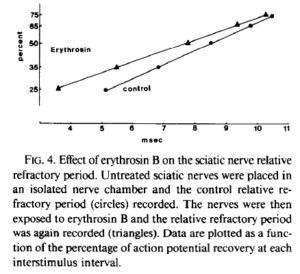 Toxicology and Applied Pharmacology. 71: 391-397.
Toxicology and Applied Pharmacology. 71: 391-397.
NOTE: This is not actually a study of Red 3. Rather, the dye, Red 3, is to help develop this testing method, because it is a known excitatory neurotoxin.
The relative refractory period is consistent in specific animal nerves, so small alterations due to neurotoxin exposure would be easily detected. On the other hand, when behavioral deficits are observed but the refractory period doesn’t change, it means the toxin is acting on the nerve endings and not the axon.




















